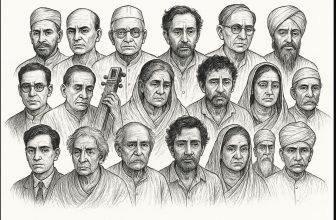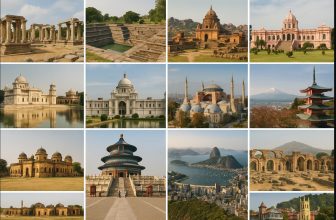India’s rich architectural heritage is filled with mysteries, and one of the most intriguing aspects is the presence of secret underground tunnels in several historic monuments. These hidden passageways were often used for military strategies, royal escapes, secret communications, or even prisoner transport. Some of these tunnels have been uncovered, while others remain hidden beneath layers of history.
Here’s a closer look at 10 Indian monuments that are known for their secret underground tunnels, revealing their history and purpose.
1. Talatal Ghar, Assam – The Hidden Fortress of the Ahom Kings
Location: Sivasagar, Assam
Built By: Ahom King Rajeswar Singha (18th Century)
Talatal Ghar, an architectural masterpiece of the Ahom dynasty, is known for its intricate multi-level structure and underground tunnels. It has seven levels, out of which three are underground, serving as escape routes and strategic defense points.
- Two hidden tunnels exist:
- One is 3 km long, connecting the palace to the Dikhow River.
- Another is 16 km long, leading to the Garhgaon Palace, the former Ahom capital.
These tunnels allowed the royal family and military officials to evacuate safely during enemy attacks. Today, visitors can explore the upper levels, but the underground sections remain closed for safety reasons.
https://sivasagar.assam.gov.in/tourist-place-detail/277
2. Charminar and Golconda Fort, Hyderabad – A Forgotten Escape Route?
Location: Hyderabad, Telangana
Built By: Muhammad Quli Qutb Shah (1591)
Legends suggest a secret tunnel between the iconic Charminar and the mighty Golconda Fort, spanning 9 km underground. This tunnel was believed to be an escape route for the Qutb Shahi rulers in case of an invasion.
- While no official records confirm its location, locals claim to have seen traces of the passage beneath certain old structures.
- In 2015, archaeologists discovered a series of archways, supporting the theory that this tunnel might exist but is buried beneath Hyderabad’s modern cityscape.
- https://hyderabad.telangana.gov.in/tourist-place/golconda-fort/
3. Delhi Legislative Assembly and Red Fort, Delhi – A Colonial-Era Tunnel
Location: Delhi
Built By: British Administration (Colonial Era)
In 2016, workers discovered an underground tunnel beneath the Delhi Legislative Assembly, linking it to the Red Fort. This tunnel, believed to be built during the British rule, was used to transport prisoners without public attention.
- Some historians believe that this passage dates back to the Mughal era, later modified by the British.
- Due to urbanization, many sections of the tunnel have collapsed, but traces of a horseshoe-shaped underground path can still be seen.
4. National Library, Kolkata – A Hidden Chamber With No Doors
Location: Kolkata, West Bengal
Built By: British Administration (1788)
The National Library of India, formerly the residence of the Lieutenant Governor of Bengal, houses a mysterious underground chamber discovered in 2010 during restoration work.
- The chamber has no visible entrances or exits, sparking theories of it being a torture cell, a treasure vault, or even a prisoner dungeon.
- No definitive proof exists regarding its original purpose, and the chamber remains sealed due to safety concerns.
This hidden chamber continues to intrigue historians and visitors alike.
5. Amber Palace, Jaipur – A Royal Tunnel to Jaigarh Fort
Location: Jaipur, Rajasthan
Built By: Raja Man Singh I (16th Century)
The Amber Palace and Jaigarh Fort are connected by a 2 km-long underground tunnel, built to protect the royal family during wars and enemy attacks.
- This fortified escape passage allowed safe movement between the two forts.
- Unlike most underground tunnels, this one has been restored and is open for visitors, offering a glimpse into the strategic defenses of the Rajput rulers.
- https://obms-tourist.rajasthan.gov.in/place-details/Amber-Fort
6. Kalaroos Caves, Jammu and Kashmir – A Path to Russia?
Location: Kupwara, Jammu and Kashmir
Built By: Natural formation, linked to ancient civilizations
The Kalaroos Caves in Kupwara district have long been rumored to contain hidden underground tunnels leading to Russia! The name ‘Kalaroos’ is derived from Qil-e-Roos, which means “Fort of the Russians.”
- Locals claim that certain tunnel-like passages inside the caves suggest connections to distant lands.
- While modern exploration has found no evidence of tunnels leading outside India, the caves remain a fascinating mystery.
7. Janjira Fort, Maharashtra – A Fort That Never Fell
Location: Murud, Maharashtra
Built By: Siddis of Janjira (17th Century)
Janjira Fort is known for being one of the few forts in India that was never conquered. A key reason was its hidden underground tunnels.
- These tunnels are believed to run beneath the Arabian Sea, linking the fort to nearby villages.
- Some say the tunnels allowed supplies and reinforcements to reach the fort during prolonged sieges.
Though much of this tunnel network has collapsed over time, parts of the passage can still be seen during fort tours.
8. Chand Baori, Rajasthan – A Stepwell with Underground Secrets
Location: Abhaneri, Rajasthan
Built By: King Chanda (9th Century)
Chand Baori, one of the deepest and most beautiful stepwells in India, is also rumored to have hidden underground tunnels.
- Folklore suggests that a secret passage exists beneath the stepwell, leading to an unknown location.
- Theories range from a royal escape tunnel to a passage leading to a hidden water source.
While the tunnels have not been fully explored, their existence remains a subject of debate among historians.
9. Belum Caves, Andhra Pradesh – A Labyrinth of Passageways
Location: Kurnool, Andhra Pradesh
Formed By: Natural Limestone Deposits (Over 1 Million Years Ago)
Belum Caves, the second-largest cave system in India, is filled with underground chambers, tunnels, and water pathways.
- Used by Jain and Buddhist monks centuries ago, the caves still contain ancient relics.
- Some tunnels extend for miles, with many unexplored sections.
These caves offer an adventurous glimpse into India’s ancient underground world. https://nandyal.ap.gov.in/adventures/
10. Kankwari Fort, Rajasthan – A Mughal Prison with Hidden Passages
Location: Sariska Tiger Reserve, Rajasthan
Built By: Maharaja Jai Singh I (17th Century)
Kankwari Fort, where Aurangzeb imprisoned his brother Dara Shikoh, is believed to contain hidden underground tunnels for secret movement.
- These tunnels may have been used to transport prisoners or send messages unnoticed.
- Since the fort is located within a tiger reserve, detailed excavations have not been conducted, keeping its secrets buried.
Closing Remarks
India’s hidden underground tunnels reveal fascinating aspects of its history, warfare, and architecture. Some of these passageways still exist, while others have been lost to time. These monuments showcase the strategic brilliance of past civilizations, offering a glimpse into the mysteries that lie beneath our feet.
Would you explore these hidden tunnels if given a chance?





